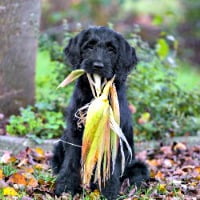Puppy Leash Training
Puppy leash training is a process with several steps which can be spaced out over a period of a few days, or a few weeks, depending on your puppy's reactions and temperament.
You can start basic manners and training as soon as you bring little Rascal home and that includes the first steps towards leash training.
Walking nicely on a leash is not a behavior which comes naturally to puppies and pulling, stalling, jumping, chewing on the leash and so on are all very common problems.
Luckily there are simple tips and tricks you can use to minimize, and eventually eliminate, these problem behaviors.
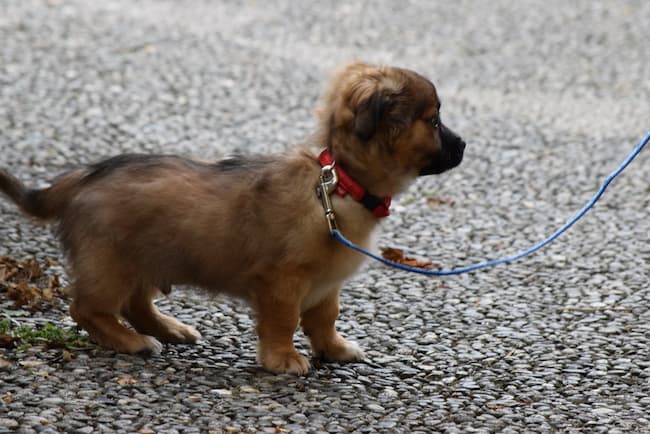
Step 1: Wearing A Collar & Leash
Once you have your new puppy at home it's a good idea to put a collar on him. This collar should have an ID tag firmly attached right from day one.
For a puppy who's spent the first few weeks of life unencumbered by clothing of any kind, the feel of a collar around his neck can be irritating, scary and uncomfortable so it may take Rascal a little while to get used to this new feeling.
Some puppies are totally unfazed by a collar and accept this new adornment without any fuss. Others try to remove it by scratching, rolling around or attempt to outrun it! It can take anything from 5 minutes to several days for a pup to feel happy wearing a collar, and this mostly depends on his temperament.
Make it easy on Rascal by choosing a lightweight collar and sizing it so that it isn't too tight.
It also shouldn't be too loose, enough room to put two fingers between his neck and the collar is about right.
Simple nylon collars are best because they're inexpensive, lightweight and washable. Something like the PUPTECK Basic Nylon Dog Collar or the Pawtitas Pet Soft Adjustable Puppy Collar would work well. Stay away from bows, bells and other noisy or distracting additions for a first collar.
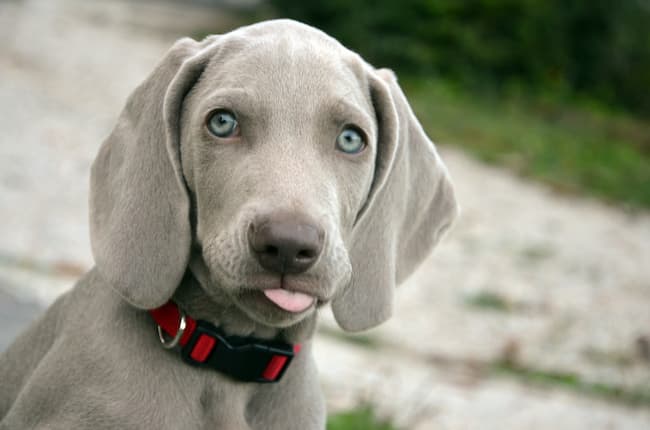
Depending on how much he likes (or doesn't like) his collar you can have him wear it for 10 minutes at a time, an hour, or all day... to begin with. Your aim is to have him wearing it happily for hours at a time and whenever he's outdoors. Take it off him when he's crated for safety reasons, and at night when he's sleeping.
A tasty treat given once the collar is attached each time is a good way to help your pup build pleasant associations with his collar. You obviously won't be doing this long term and can phase out the treats once he's familiar with the process.
Once little Rascal has accepted his collar the next move in puppy leash training is to actually add the leash.
A leash is an added weight on the collar, and once again you'll need to give your puppy a chance to get familiar with that feeling. I'd also recommend a lightweight nylon leash as a starter leash for the same reasons given for the collar. Leather leashes look nice and are a great choice for an older, leash-trained puppy or an adult dog, but they're heavy and very appetizing to a pup who still loves to chew.
Attach leash to your puppy's collar and then let him drag it around without you on the other end. Again, some puppies are nervous about this, others think it's a super fun game. Either way, allow him to wander around with the leash dragging for a few minutes several times a day so that he gets comfortable with that added weight. Only do this in a fairly confined space, where you can see him at all times.
Don't let him chew on his leash, it's not a toy. Puppies often want to chew the leash when walking anyway and you don't want him to think that's okay at this point.
Watch that puppy!
Always supervise your pup closely, and continuously, whenever he's dragging a leash behind him.
There's the potential for it to get caught up or snagged on furniture, doorways etc. and that could scare him, or even injure him.
It's up to you to make sure this doesn't happen.
Step 2: Leash Walking With Mom/Dad
Moving onto the next stage in puppy leash training involves the jump from little Rascal dragging his leash around to having mom or dad acting as an anchor on the other end of it. This can be a big change for a puppy.
Start the first actual puppy leash training lesson by first letting your pup run around with his leash dragging for a couple of minutes and then:
- Go over to your puppy and pick up the leash
- Get his attention by using his name
- Then use a cue word such as "Let's go" or "Come on"
- Take a few steps away from him so he will follow
Young puppies (under three or four months) generally want to be right by your side, and this is a plus when it comes to leash training your puppy because little Rascal will most likely follow you as you move away from him while holding the leash. That's a win.
You are NOT aiming for a 'heel' position (where your pup is close to your left leg), at this stage all you want is for your pup to follow you while you hold the leash. Once little Rascal has followed you for a few steps hold a TINY tasty treat (you don't want him to have to take time to chew it up) next to your leg at his head height and let him take it out of your fingers. Then use your cue word and move forward again.
Depending on his personality, your little Rascal may take to this without missing a step (literally or figuratively), or he may freeze and refuse to move or flop around like a fish or fight/chew his leash as though it's a poisonous snake out to get him!
Puppy Leash Training Problems
Puppy leash training is sometimes in danger of becoming a battle of wills when little Rascal isn't inclined to co-operate.
The keys to dealing with leash walking behavior problems lie in rewarding good behavior, using distraction whenever possible and refusing to be drawn into a tug or war or losing your cool.
Patience is definitely required.
Puppy refuses to walk:
If your puppy refuses to walk or move, take a few steps away from him (still holding the leash) and then crouch down and encourage him to come to you. Give him his treat and then stand up, use the cue word and try again. It may take several tries, or even several sessions, for him to start to follow you.
Never try to drag a reluctant puppy, you could hurt his neck or larynx and will only succeed in scaring him and making him distrust the leash even more.
With a pup who stubbornly refuses to walk, or who flops down and won't budge, there's one other thing to try.... take a few steps backwards until you're behind him, then jog forward past him while calling his name. Many times a pup will instinctively jump up to chase you. Once that happens slow down, stop and give him his treat... then try walking forward again.
Puppy chews on his leash:
If your puppy wants to chew and pull on his leash whenever you try walking it's easy to find yourself in an impromptu game of tug-of-war.
This is a game which all puppies and dogs instinctively play, and love, and it's exactly what they're doing in this situation... playing.
However, you're busy with the puppy leash training lesson and it's not the right time to be playing this particular game.
There are several different things you can do to help deal with a puppy who chews on his leash.
Some are physical deterrents which make the act of biting or chewing on the leash uncomfortable. Others use distraction or a change of pace to change the behavior.
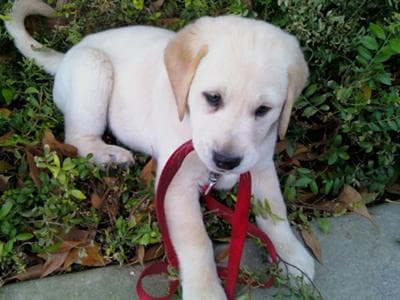
Here are some of the puppy leash training tips and tricks I've used to deal with this behavior:
Making the leash less appealing
The simplest way to make little Rascal's leash less appetizing is to spray it with Bitter Apple so that when your puppy bites it he gets a nasty taste in his mouth. Some puppies really hate Bitter Apple spray, others barely seem to notice it. If your puppy isn't put off by this taste you can try mouthwash (the mint flavored ones), vinegar or even hot sauce. The last one is a bit messy and I've not had to resort to it but have heard it works!
Another option is to replace the nylon leash with a chain one. These are also heavy, so choose the lightest, finest and shortest chain leash you can. Puppies do NOT like to bite down on a metal chain and this can short-circuit the tug of war game pretty quickly.
Avoid tug-of-war
When a pup starts to chew on his leash he also tugs or pulls on it with his teeth. This tugging is natural, instinctive behavior to a pup and if you pull back he will simply tug harder too. Before you know it you're in a tug-of-war game that you don't want to play.
There are a couple of ways you can prevent this happening:
Keep your puppy's mouth occupied by allowing him to carry something on his walks. A favorite toy or a short, sturdy stick that is kept just for this purpose are good choices. Don't choose something heavy or awkward for him to hold. The aim is to satisfy his 'mouthiness' and keep his attention away from the leash, but he needs to be comfortable doing that.
Using a harness instead of a collar makes it trickier for your pup to grab the leash because it's anchored further behind his head than with a regular collar. There are several different styles and choices when it comes to harnesses.
The best choice for a puppy is a harness where the leash attaches to a ring located behind the shoulders (on the top of the harness). The Puppia Dog Harness or the PUPTECK Mesh Dog Harness are both good choices.
Front-clip harnesses are not a good choice for puppies in general (and not helpful for the chewing issue with puppy leash training) because the pressure put on the shoulders and front legs can potentially cause damage and affect growth/development.
Puppy pulls on his leash
All puppies pull on their leashes at some point early on, it's perfectly normal because they're not used to being restrained, and always in a hurry to be somewhere!
When you first start out with puppy leash training you're focused on getting Rascal to tolerate his collar and leash, and to keep him moving in the right general direction. Whether he's pulling ahead of you isn't important at this point.
However, once your puppy is happy to walk with you it's important begin to gently encourage your pup to move at your pace and not to pull forward, or backwards.
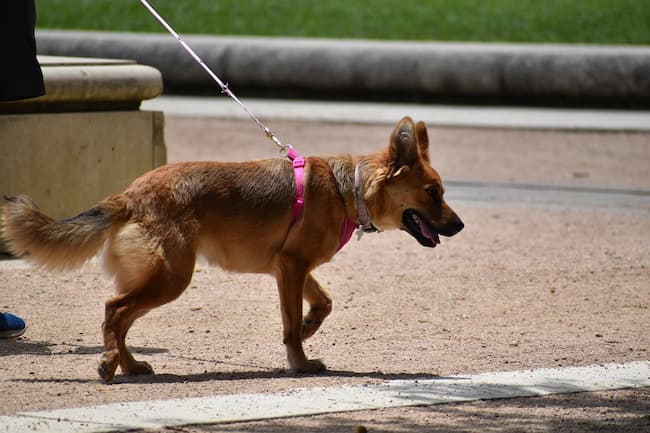
This first puppy leash training tip for dealing with a puppy who pulls might seem counter-intuitive, but it works....
When little Rascal starts lunging forward, tugging you sideways, or even pulls backwards, you need to stop moving. If you stand completely still, your pup loses all momentum, and is confused by your sudden lack of motion, and will also stop walking, and pulling.
Once he stops pulling use his name and your cue word (ie. "Rascal, lets go" or "Rascal, come on") and start walking again. If he pulls, you stop again. Yes, there will be a LOT of stop-and-go movement in the beginning as your pup will take a little time to connect the dots. But sooner or later he will realize that if he pulls, yanks or tugs on the leash, you stop moving. That isn't what he wants so he will learn not to pull if he wants to go for a walk.
You can also tweak this a little bit if you prefer and instead of stopping when Rascal pulls ahead, you can simply turn and start walking in the opposite direction. He will be forced to turn too. Again, there will be a lot of to-and-fro and directions changes, and it can become a little frustrating for both of you, but once your pup realizes that his pulling is the trigger for your change of direction he will start to ease up on that.
Once your pup is walking beside you without pulling most of the time you're well on your way to great leash manners.
For leash training that goes beyond this and teaches the 'heel' position and more, I strongly recommend enrolling your puppy in a Basic Puppy Obedience Class where loose leash walking will be one of his earliest lessons.
Puppy training classes which are run by professional dog trainers (I don't personally recommend Petsmart type classes and suggest looking for a professional dog training school in your area) are a wonderful way for you and Rascal to learn together. You benefit from experienced, hands-on help and your puppy gets valuable socialization as well as training. It's a win-win.
Help Rascal enjoy his leash training lessons
It's important to make any type of puppy training fun for little Rascal, and puppy leash training is no exception.
Use plenty of treats as rewards for good behavior (ie following you, NOT chewing or playing tug-of-war with the leash, and eventually walking nicely without tugging/yanking you along.
Keep training sessions short and always end on a positive note with your puppy doing something well and being rewarded with plenty of praise, treats and love.
You Might Also Like:
- Home
- Leash Training

